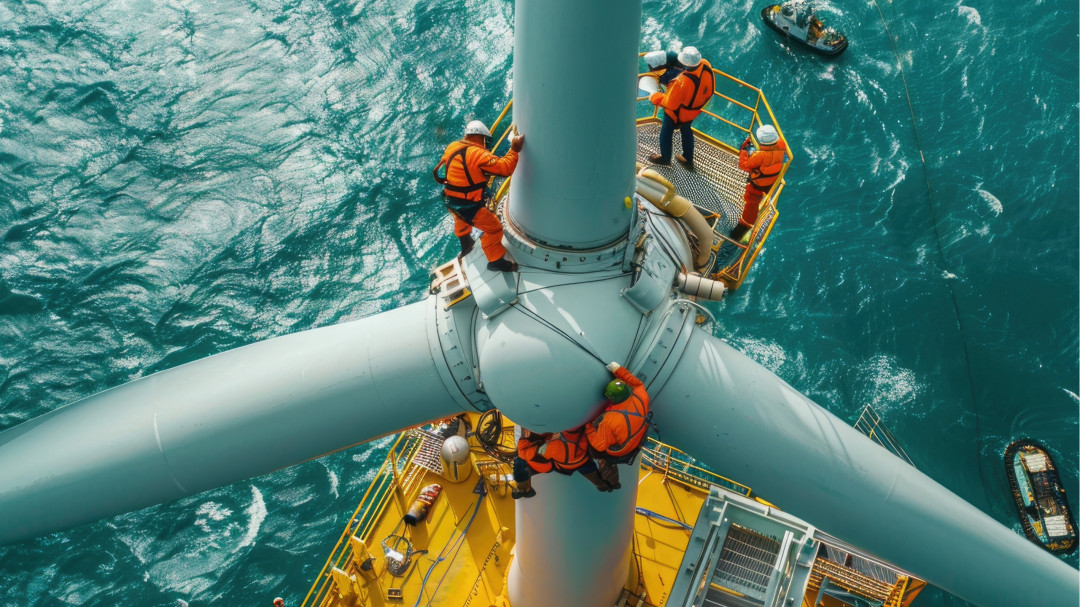
In order to get the expansion of offshore wind power back on track, additional measures are needed to ensure that the ramp-up is secured. This is because delivery bottlenecks and price increases are currently delaying the expansion of offshore wind power. Suppliers of important components for offshore wind farms, such as castings for rotor hubs, foundations or cables, are having difficulties ramping up their production quickly enough. The supply bottlenecks also affect the grid operators, who have already announced that the grid connection for some offshore wind farm projects will be delayed by one to two years – and thus also the achievement of the targeted offshore target for 2030. In six years, the federal government plans to achieve a capacity of 30 gigawatts of offshore wind power, more than three times the existing 9 gigawatts. By 2045, it should be 70 gigawatts.
In order to get the offshore expansion back on track in the medium term, Agora Energiewende has formulated proposals for solutions in a new impulse paper. These include measures that can be implemented quickly, such as strengthening supply chains, for example through guarantee and credit programmes for supplier companies, but also proposals for securing offshore expansion in the medium and long term. These include, for example, a more predictable and profitable ramp-up of production and port capacities through higher tender volumes after 2030 and rules for dealing with project cancellations. In addition, there is a need for better coordination of the expansion with Germany's neighbouring countries in order to use infrastructure efficiently and avoid wind farms at sea taking away each other's wind.
"Ambition and implementation are currently still out of sync when it comes to offshore wind power. In particular, the shortage of production capacities for wind turbines and the sluggish expansion of the grid are currently causing problems with the timely commissioning of offshore wind farms," says Simon Müller, Director of Agora Energiewende Deutschland. "To break the logjam, it is now important to strengthen the supply chains for offshore plants and secure investments. This will accelerate the expansion so that we can achieve our goals and at the same time build key industries for climate neutrality in a targeted manner." Offshore wind power will also play an important role in the future for the production of green hydrogen. This is because the wind blows more and more evenly at sea, making hydrogen production more economical.
The fourth round of tenders is due to take place in August, following the increase in targets decided on by the federal government a good two years ago. In summer 2022, the coalition agreement raised the offshore target by 10 gigawatts to 30 gigawatts by 2030. To meet the increased demand for offshore wind power, Agora Energiewende is proposing a package of measures that can be implemented in the short term. These include, for example, better financing programmes via the KfW for the development of production capacities. According to the study, investments of between 300 and 700 million euros will be needed for the construction of new factories for the production of monopiles alone – however, the maximum credit limit via the KfW is currently only 25 million euros.
In addition, a stabilisation of the annual expansion targets after 2030 could give manufacturers and suppliers better planning security. This is because a short-term peak in demand is currently expected between 2029 and 2031, followed by a sharp decline at the beginning of the 2030s. To make it worthwhile for manufacturers, suppliers and ports to expand their capacities, Agora Energiewende is proposing an increase in the tender volumes after 2030. "Companies can adapt much better to the upcoming demand if they can expect a more even order situation," says Müller. "To provide more planning certainty, it therefore makes sense to increase the tender volumes to five to six gigawatts per year after 2030 – instead of the four gigawatts per year that have been planned so far."
In addition, the think tank proposes that bidders be required to pay 15 per cent of their bid in the first twelve months after the award. This should increase the likelihood of project realisation. So far, bidders have had to spend five per cent of the bid on marine protection and sustainable fishing, with the remaining 90 per cent of the payment only falling due when the wind farm is commissioned. Agora also recommends the introduction of a levy of five per cent of the bid for the development of port capacity, which is needed for the transport and storage of turbines, for example. Such a levy would have generated around 150 million euros in the tender in June 2024. In addition, the Agora paper suggests that in the event of a project being cancelled, there should be rules for the rapid reallocation of offshore space. This has become more important, especially in view of the increased cost pressure due to higher commodity prices.
"A far-sighted policy is needed to ensure that offshore wind energy can make its contribution to climate neutrality," says the German director of Agora Energiewende. That is why the think tank also proposes longer-term measures, such as coordinated planning with neighbouring European countries for infrastructure and areas for offshore wind energy projects. With the reduction in project costs, the expansion of offshore wind energy has gained in importance across Europe, says Müller: "The German government should actively support the joint and efficient use of infrastructure for offshore wind farms at the EU level. In addition, coordinated land use planning is important to avoid shadowing effects from neighbouring wind farms."

